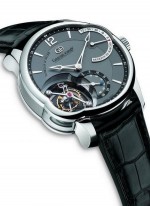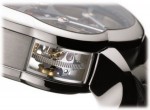At its source and leading Greubel Forsey, are the «Mechanical Architects» of the Double Tourbillon 30°, Robert Greubel and Stephen Forsey who met each other some ten years ago. One comes from Alsace, France the other from the United Kingdom, which contradicts the historical competition that has always existed between these two watchmaking nations. Here then, an example of an exceptional partnership working in search of perfection.
Robert Greubel (1960)
In possession of a watchmaker CAP title, he first repaired watches in his father's shop, before returning to school. He graduated from the Ecole d'horlogerie in Dreux, France. It was here he discovered complicated horology. He became a prototypist at IWC where he participated in the Grand Complication project. He then worked for Audemars Piguet (Renaud & Papi) SA. Working as a prototypist, he participated in numerous projects and later became the co-general director and a partner in the company.
Stephen Forsey (1967)
This English watchmaker was born in St. Albans where tens of thousands of Marine Chronometers were once produced. As is his father, passionate about all things mechanical, he became a watch restorer at Asprey. He is now near to fulfilling his dream that of creating bespoke clocks. In Switzerland in 1992, he met Robert Greubel, the French man at Renaud & Papi. Within the company, he excelled in working with Grandes sonneries, Repeaters, Carillons, Perpetual Calendars and of course, Tourbillons. In 2001, the two watchmakers created CompliTime SA in la Chaux-de-Fonds, a company dedicated to the development of complicated movements for prestige watchmaking. By launching Greubel Forsey, the inventors of the Double Tourbillon 30° want to create new watchmaking complications that benefit from today's technical possibilities, in very small numbers, for the delight of collectors and knowledgeable wristwatch devotees. All models will be individually numbered and engraved by hand.
A decisive invention
When Robert Greubel and Stephen Forsey decided to develop a high performance version of the famous Tourbillon regulator, they wished not only to pay homage to its inventor, Abraham Louis Breguet, but also to surpass existing accomplishments and to make a decisive contribution in the development of this precious mechanism. Indeed, the regulator and the escapement had always been the weak points of the watch movement. For more than three centuries, experts from all disciplines, from mathematics to mechanics, from metallurgy to physics, strived to improve the functioning of the movement in these areas. Once their constructions were perfected, after imagining a multitude of different concepts, these men then sought to control the exterior influences affecting the mechanism: temperature, barometric pressure, gravity and magnetic fields. With regards to multi-axis Tourbillon's more specifically, Greubel Forsey's attention was caught by fundamental research carried out by watchmakers Anthony Randall and later Richard Good. In both cases, their mechanisms were incorporated into carriage clocks with Tourbillon cages linked by 90 degree angles. In order to respond to the very specific requirements for a wristwatch, Greubel Forsey introduced a construction as yet unseen in watchmaking: a Double Tourbillon where the second carriage is inclined at 30° and is placed inside the first carriage. This construction constitutes a significant step forward when compared to other possible solutions: - Superior performance of the system in extreme wristwatch positions. - Reduced volume of the timepiece while achieving an optimal size of the system. - Maximum visual access of the functioning mechanism. This configuration has enabled the construction of a spectacular movement: the Double Tourbillon 30° can be observed in its entirety. Furthermore, its dimensions have enabled it to be presented as a comfortably-sized wristwatch. The Greubel Forsey invention appreciably improves the time-keeping performance. This is shown by the graph which compares the running time results in the different wristwatch positions simulated on the Double Tourbillon 30° by using first the Greubel Forsey balance wheel in a fixed position (without Tourbillon), followed by one simple functioning cage (classical Tourbillon) and finally by the Double Tourbillon 30°. The best performance is represented by a series of values nearing a linear representation.







